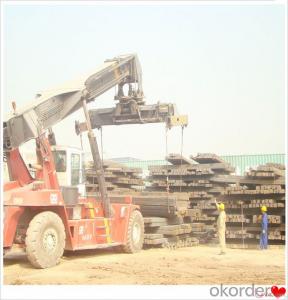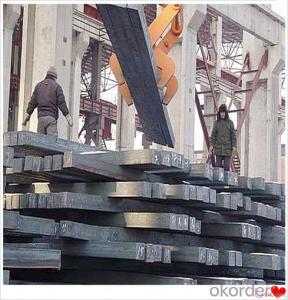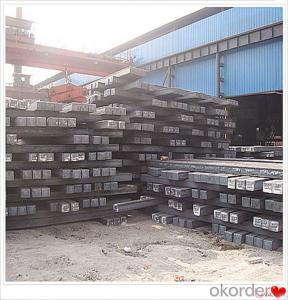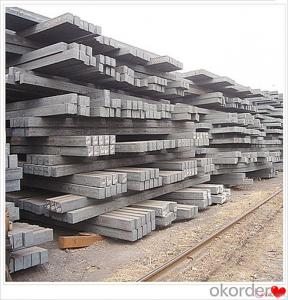Billet Steel Producers Q235,Q255,Q275,Q345,3SP,5SP,20MnSi
- Loading Port:
- China main port
- Payment Terms:
- TT OR LC
- Min Order Qty:
- 20 m.t.
- Supply Capability:
- 200000 m.t./month
OKorder Service Pledge
OKorder Financial Service
You Might Also Like
Billet Steel Producers Q235,Q255,Q275,Q345,3SP,5SP,20MnSi
Specification
Steel billet(ingot) by cogging or breakdown of semi-finished products, is the raw material of all kinds of steel mill. Billet section of square, round, flat, rectangular and abnormity of several kinds of, mainly related to the shape of rolled products.
CNBM Q235,Q275,Q345,3SP,5SP,20MnSi Billets Steel
Hot Rolled Steel Billets/ Mild Steel Bar/ Billet Steel
Specification (see below)
Standard: GB/JIS/ASTM
Size: 50*50mm-180*180mm
Length: 3-12mtrs or Customised
Steel material: Q235,Q255,Q275,Q345,3SP,5SP,20MnSi
Technique: Hot rolled
FOB Unit Ton Price $250-350 and Usually I will quote you CFR price.
MOQ: Usually 1000-10000MT/size
Shipment:By Container,Bulk Vessel
Packaging Details: bundles with steel strips or as customers's requirements
Delivery time: Usually within 30 days after the deposit/LC
Inspection:Third party inspection before loading.
Technical data
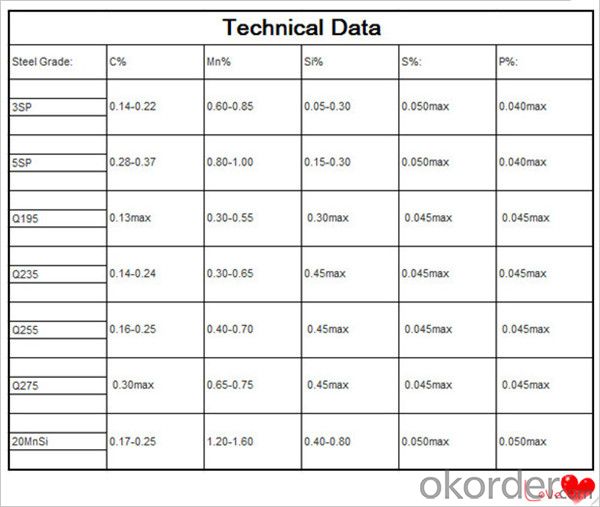
Feature Steel Billet
Rectangular billet continuous casting billet and mainly general carbon steel, low carbon low silicon cold-rolled material, high quality carbon structural steel, high strength low alloy steel, special steel, etc.
The billet is mainly divided into two kinds from the shape:
Slab: cross section width and height of the ratio of the larger, mainly used for rolling plate.
Billet: equal cross section width and height, or a huge difference, mainly used for rolling steel, wire rod. ,
Steel billets have distinct characteristics as compared with already furnished steel bars and products. Billets have a specific grain structure, which enables the metal to be processed more intricately. Steel billets are also known for their malleability and ductility, especially when exposed to varying temperatures during shaping and molding.
Packaging & Shipping
1. Packaging:
1) Small size: in bundles
2)Big size: in bulk
3)in plastic packing or as per customer requirement
2. Delivery time:
1) Normal size: within 7days send from warehouse directly
2) Special size: with 25-30days customer made for you
3. Trade terms:FOB/CFR/CIF
4. Shippment:
1) length:≤5.8m loaded in 20FT Container with 25-27tons
2) length:≤11.8m loaded in 40FT Container with 25-27tons
3) lengnth:≥12m shipped by bulk vessel, FILO terms
Steel Billet Images
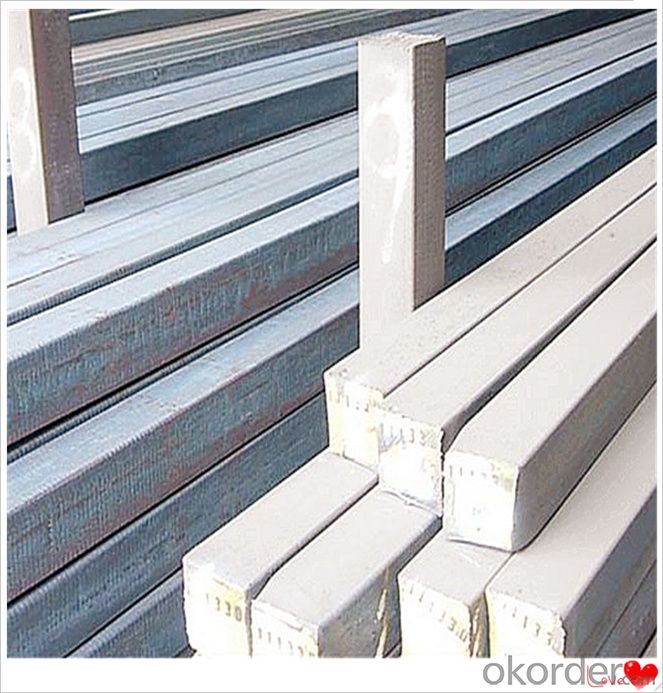
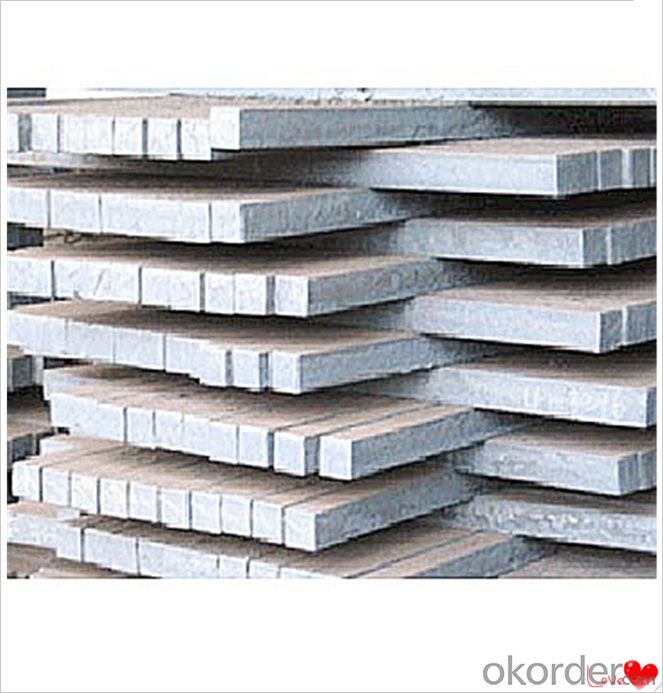
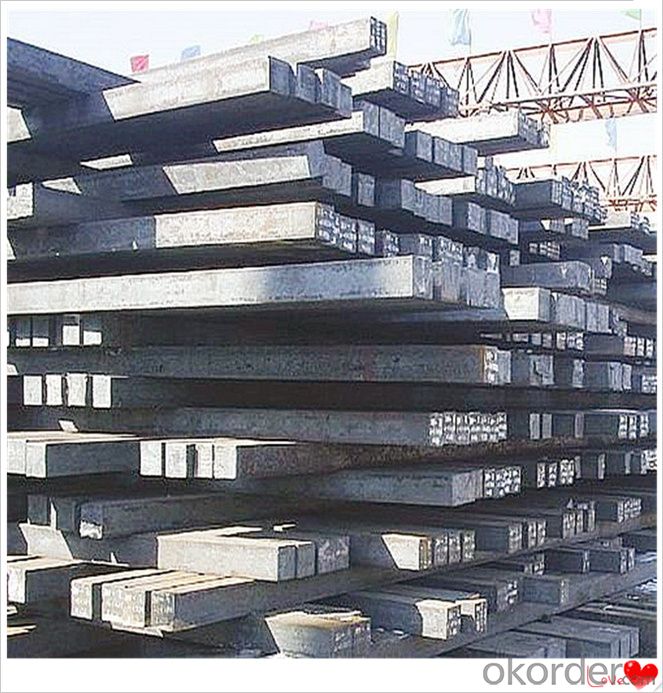

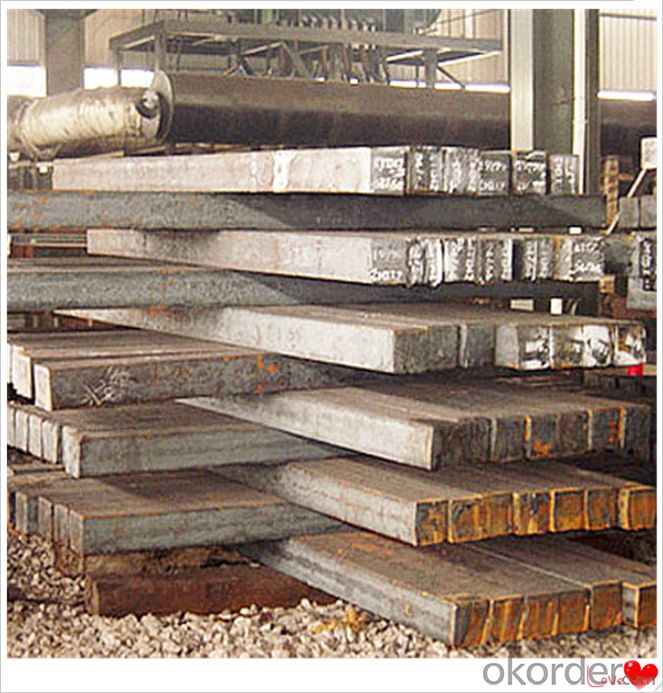
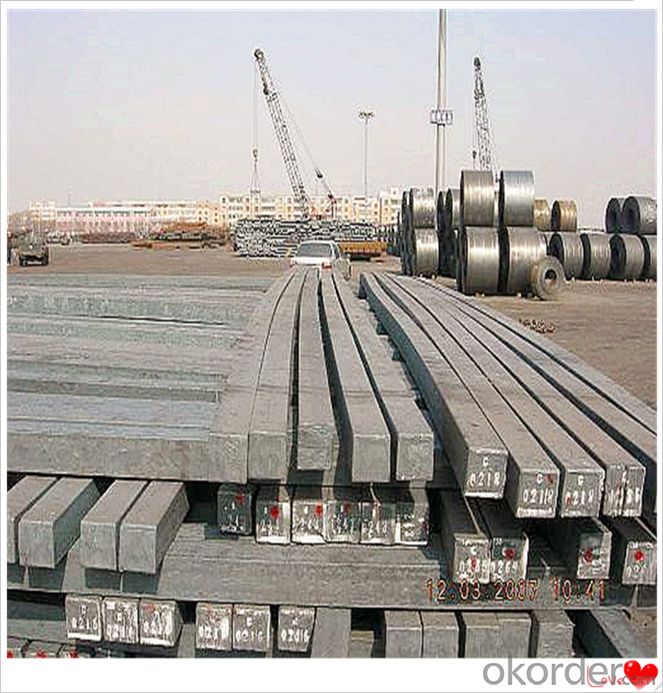
Processing
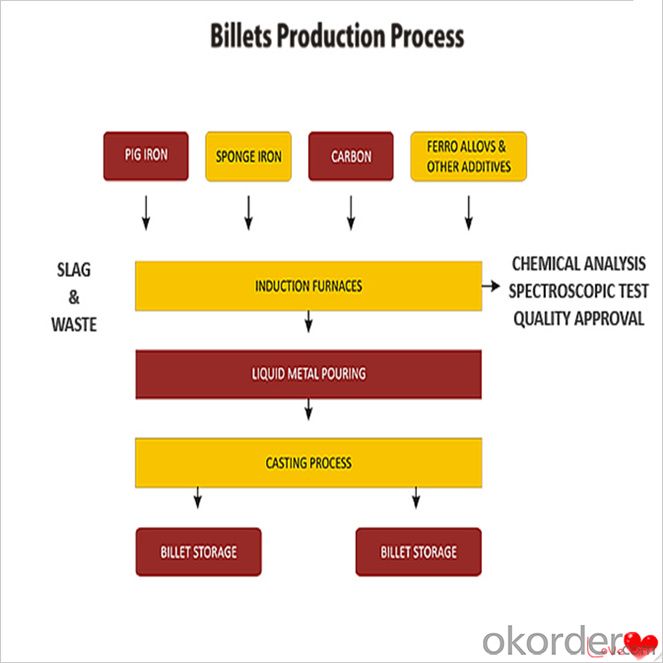
Usage-Billet Steel
Used for the plant, the bridge,shipment building high-rise building construction,lifting and transportation machinery, equipment manufracturing base building the support foundation pile manufacturing.
Billets, or ingots (as they sometimes referred to), are not of practical use until they have been formed into more functional shapes and sizes. While they have already been put in the furnace, they still require a series of shaping and molding procedures such as hot and cold working, milling and cutting before they are sold in hardware stores, or used for different applications. The unformed billets, however, can be used in striking currency such as coins and as reserves, similar to gold bars.
FAQ-Billet Steel
We have organized several common questions for our clients,may help you sincerely:
1) How about your company?
A world class manufacturer & supplier of castings forging in carbon steel and alloy steel,is one of the large-scale professional investment casting production bases in China,consisting of both casting foundry forging and machining factory. Annually more than 8000 tons Precision casting and forging parts are exported to markets in Europe,America and Japan. OEM casting and forging service available according to customer’s requirements.
2) How to guarantee the quality of the products?
We have established the international advanced quality management system,every link from raw material to final product we have strict quality test;We resolutely put an end to unqualified products flowing into the market. At the same time, we will provide necessary follow-up service assurance.
3) How long can we receive the product after purchase?
In the purchase of product within three working days, We will arrange the factory delivery as soon as possible. The pecific time of receiving is related to the state and position of customers.Commonly 7 to 10 working days can be served.
4)Do you have your own QC department?
Yes, we have, our QC department will inspect the goods during the process of mass production and after completion of production.
hot sale!!! Cast Steel Grades/ mild steel bar/ billet steel
(1): High quality steel with reasonable price.
(2): Wide excellent experiences with after-sale service.
(3): Every process will be checked by responsible QC which insures every product's quality.
(4): Professional packing teams which keep every packing safely.
(5): Trial order can be done in one week.
(6): Samples can be provided as your requirements.
- Q:How are steel billets used in the production of agricultural components?
- Various agricultural components rely on steel billets as an essential raw material. These billets act as the foundation for the manufacturing process and are transformed into a diverse range of agricultural components, including plows, harrows, tillers, cultivators, and seeders. Initially, the steel billets are melted and cast into a solid form, usually rectangular or square, with a consistent cross-section. This solid steel piece is then heated and rolled into the desired shape and size required for the specific agricultural component being produced. After rolling and shaping the billets, they undergo further processes such as cutting, drilling, bending, and welding to create the final agricultural component. These components are specifically designed to endure the demanding conditions of the agricultural industry, including exposure to harsh weather, heavy loads, and frequent use. Steel billets offer several advantages in the production of agricultural components. Firstly, steel is a sturdy and resilient material that provides the necessary strength and durability for effective agricultural machinery operation. Additionally, steel is highly resistant to corrosion, ensuring that the agricultural components can withstand exposure to moisture, fertilizers, and other commonly used farming chemicals. Moreover, steel billets can be easily customized and fabricated into various shapes and sizes, allowing for the production of a wide variety of agricultural components tailored to specific farming needs. The versatility of steel billets also enables manufacturers to create components with intricate designs and features, enhancing their functionality and performance. In conclusion, steel billets play a crucial role in the production of agricultural components. The versatility, strength, and durability of steel make it an ideal material for manufacturing machinery and equipment used in the agricultural industry. By starting with steel billets and transforming them through various manufacturing processes, agricultural components are created that can withstand the demanding conditions of farming, contributing to the efficiency and productivity of agricultural operations.
- Q:What are the main factors affecting the fatigue strength of steel billets?
- The fatigue strength of steel billets can be influenced by several key factors. 1. Material Composition: The fatigue strength of a steel billet depends on its composition, including the type and quantity of alloying elements present. Elements like carbon, manganese, and silicon have an impact on the billet's ability to resist fatigue and endure cyclic loading. 2. Surface Quality: The fatigue strength of steel billets is closely tied to their surface quality. Surface defects, such as cracks, scratches, or pits, can act as stress concentrators, leading to premature fatigue failure. Therefore, it is imperative to properly prepare and inspect the surface to ensure high fatigue resistance. 3. Heat Treatment: The fatigue strength of a steel billet can be significantly influenced by the heat treatment process used to modify its microstructure. Employing appropriate heat treatment techniques, like quenching and tempering, can enhance the billet's fatigue resistance by improving its hardness, strength, and toughness. 4. Grain Size: The fatigue strength of a steel billet is also affected by the grain size of its microstructure. Finer grains generally exhibit greater fatigue resistance due to reduced stress concentration and enhanced grain boundary strength. 5. Residual Stress: Residual stresses, which can arise from various manufacturing processes, play a crucial role in determining the fatigue strength of steel billets. Excessive residual stress can serve as a starting point for fatigue cracks, thereby diminishing the billet's fatigue life. 6. Operating Conditions: The fatigue strength of steel billets can be influenced by the conditions under which they operate. Factors such as the magnitude and frequency of applied cyclic loads, as well as the temperature, can all have a detrimental impact on the billet's fatigue life. 7. Environmental Factors: The environment in which a steel billet operates can also affect its fatigue strength. Variables like humidity, corrosive gases, and exposure to chemicals can accelerate the initiation and propagation of fatigue cracks, resulting in reduced fatigue resistance. Taking into account and comprehending these primary factors that impact the fatigue strength of steel billets is crucial when designing components and structures that can endure cyclic loading and ensure long-term reliability.
- Q:What are the different methods used for heating steel billets?
- There are several different methods used for heating steel billets, depending on the specific requirements and constraints of the application. Some of the common methods include: 1. Induction Heating: This method uses electromagnetic induction to heat the steel billets. An alternating current is passed through a coil, creating a magnetic field that induces electrical currents in the billet, generating heat. Induction heating provides precise and controllable heating, allowing for uniform heating throughout the billet. 2. Gas Furnaces: Gas furnaces utilize burners to generate heat, which is then transferred to the steel billets through convection. Natural gas or propane is commonly used as the fuel source. Gas furnaces offer flexibility in terms of temperature control, heating rate, and energy efficiency. 3. Electric Resistance Heating: In this method, electric current is passed through resistive elements, such as heating elements or heating pads, that are in direct contact with the steel billets. The resistance to the electric current generates heat, which is transferred to the billets. Electric resistance heating is commonly used for smaller-scale operations or applications with specific heating requirements. 4. Flame Heating: Flame heating involves the use of an open flame, typically generated by a gas burner, to heat the steel billets. The billets are heated by the radiant heat emitted from the flame. Flame heating is often used for larger billets or in applications where rapid heating is required. 5. High-Frequency Heating: High-frequency heating utilizes electromagnetic fields to heat the billets. The billets are placed inside a coil, and a high-frequency alternating current is passed through the coil, inducing electrical currents in the billets. The resistance to the electrical currents generates heat, resulting in rapid and uniform heating. 6. Laser Heating: Laser heating involves the use of high-powered lasers to heat the steel billets. The laser beam is focused on the surface of the billet, generating intense heat through the absorption of the laser energy. Laser heating offers precise and localized heating, making it suitable for specific applications or for heat treating small areas of the billets. These are just a few of the methods commonly used for heating steel billets. The choice of method depends on factors such as the required heating rate, temperature control, energy efficiency, and the specific characteristics of the billets being heated.
- Q:What are the different types of defects in steel billets?
- There are several types of defects that can occur in steel billets, which are essentially semi-finished steel products that are typically used as raw materials for various manufacturing processes. These defects can arise during the production or handling of billets and can affect their mechanical properties, structural integrity, and overall quality. Some common types of defects found in steel billets include: 1. Surface defects: These defects are typically visible on the outer surface of the billet and can include scratches, cracks, pits, or scale. Surface defects can occur due to improper handling, storage, or transportation of the billets, or as a result of poor manufacturing processes. 2. Internal defects: Also known as sub-surface defects, these occur within the cross-section of the billet and are not visible to the naked eye. Internal defects can include blowholes, inclusions, segregations, or voids. These defects can be a result of impurities in the raw materials, improper casting or solidification processes, or inadequate quality control measures. 3. Dimensional defects: These defects refer to deviations in the dimensions of the billet from the specified requirements. This can include variations in length, width, or thickness beyond the acceptable tolerances. Dimensional defects can be caused by factors such as improper cutting, rolling, or cooling processes during billet production. 4. Chemical composition defects: These defects occur when the steel billet does not meet the required chemical composition specifications. This could be due to impurities in the raw materials, improper mixing or alloying processes, or inadequate quality control during the production phase. 5. Mechanical defects: These defects affect the mechanical properties of the steel billet, such as its strength, toughness, or ductility. Mechanical defects can result from improper heat treatment, quenching, or tempering processes, or from inadequate quality control during the manufacturing process. It is important to detect and minimize these defects as they can adversely affect the performance and reliability of the final steel products that are made from these billets. Quality control measures, such as regular inspection and testing, can help identify and rectify any defects in steel billets, ensuring the production of high-quality finished products.
- Q:How are steel billets used in the manufacturing of machine parts?
- Machine parts manufacturing heavily relies on steel billets, which serve as vital raw materials. These billets, solid and semi-finished steel products, are cast into specific shapes and sizes. The utilization of steel billets involves a series of stages. To begin with, the steel billets are heated in a furnace to a specific temperature. This heating process softens the metal, increasing its malleability. Once the desired temperature is reached, the billets are ready for further processing. Subsequently, the heated billets are transferred to a rolling mill, where they undergo hot rolling. During this process, the billets are subjected to pressure from a series of rollers, which shape them into bars, rods, or sheets according to the desired form. The hot rolling process ensures that the steel billets acquire the necessary dimensions and surface finish. Following hot rolling, the shaped steel billets undergo additional processing techniques, such as cutting, forging, or machining, to fabricate machine parts. These parts can encompass gears, shafts, valves, or any other components essential for machinery. The utilization of steel billets in machine parts manufacturing provides several advantages. Firstly, steel billets are renowned for their high strength and durability, making them ideal for producing parts capable of withstanding heavy loads and harsh operating conditions. Additionally, the malleability of steel billets enables the creation of intricate shapes and designs, ensuring the production of complex machine parts. Furthermore, steel billets can be easily customized to meet specific requirements. They can be alloyed with other metals or undergo various heat treatments to enhance properties such as hardness, corrosion resistance, or wear resistance. This versatility of steel billets makes them suitable for a wide range of machine parts across diverse industries. In conclusion, steel billets play a pivotal role in machine parts manufacturing. Through processes like hot rolling, cutting, forging, and machining, steel billets transform into diverse shapes and sizes, yielding durable and high-quality components for machinery. The strength and adaptability of steel billets render them indispensable raw materials in the manufacturing industry.
- Q:What are the different types of steel billet surface treatment defects?
- There are several types of steel billet surface treatment defects that can occur during the manufacturing process. These defects can affect the quality and appearance of the steel billets, and it is important to identify and address them to ensure the overall performance of the final product. 1. Scale: Scale is a common defect that occurs when the steel billet is exposed to high temperatures during the manufacturing process. It appears as a layer of oxide on the surface of the billet, which can affect the adhesion of coatings or paints. 2. Inclusions: Inclusions are non-metallic particles or impurities that can be present on the surface of the steel billet. These inclusions can be caused by various factors, such as inadequate cleaning or improper handling during the manufacturing process. They can negatively impact the mechanical properties of the steel and reduce its overall performance. 3. Decarburization: Decarburization is a defect that occurs when the surface layer of the steel billet loses its carbon content due to exposure to high temperatures or a lack of protective atmosphere. This can lead to reduced hardness and strength in the affected area. 4. Pitting: Pitting is a localized defect that appears as small cavities or pits on the surface of the steel billet. It can be caused by the presence of impurities or by exposure to corrosive environments. Pitting can compromise the structural integrity of the billet and make it more susceptible to corrosion. 5. Surface cracks: Cracks can occur on the surface of the steel billet due to various factors, such as thermal stress, improper handling, or inadequate cooling. Surface cracks can weaken the billet and increase the risk of failure during subsequent processing or use. 6. Surface roughness: Surface roughness refers to an uneven or irregular surface texture on the steel billet. It can be caused by factors such as improper machining, inadequate cleaning, or the presence of scale or inclusions. Surface roughness can affect the appearance of the billet and may also impact its performance in certain applications. Overall, it is crucial to identify and address these surface treatment defects to ensure the quality and reliability of steel billets. Proper manufacturing processes, including adequate cleaning, protective atmospheres, and appropriate handling, can help minimize the occurrence of these defects and ensure the optimal performance of the final product.
- Q:What are the different packaging options available for steel billets?
- Steel billets can be packaged in various ways to meet the specific needs and preferences of customers. Here are some commonly used packaging options: 1. Wooden Crates: To ensure safe transportation and storage, steel billets can be secured in sturdy wooden crates. These crates offer protection against moisture and physical damage. 2. Steel Frames: Another option is to package the steel billets using steel frames. These frames, made of strong and durable steel bars, securely hold the billets in place, providing stability and protection. 3. Plastic Wrapping: Plastic wrapping is also a viable packaging method. It involves tightly wrapping the billets with plastic film to shield them from dust, moisture, and scratches. 4. Wire Binding: Steel billets can be bundled together using steel wires, a common packaging choice. This method ensures stability and prevents movement during transportation. 5. Customized Packaging: Some customers may require customized packaging for their steel billets. This can involve using specific materials like foam or cardboard for added protection, or incorporating branding elements on the packaging. Ultimately, the choice of packaging depends on factors such as billet size and weight, mode of transportation, and specific customer requirements. It is crucial to consider factors such as protection, stability, ease of handling, and cost-effectiveness when selecting the most suitable packaging option for steel billets.
- Q:What is the weight of a standard steel billet?
- The weight of a standard steel billet can vary depending on its dimensions, but typically ranges from 1 to 6 metric tons.
- Q:What is the role of steel billets in the shipbuilding industry?
- The shipbuilding industry relies heavily on steel billets as they are the primary material used to build the structural components of ships. These billets, which are semi-finished steel products, are made by casting molten steel into rectangular shapes that can be further processed into various shipbuilding parts. Using steel billets in shipbuilding offers several advantages. Firstly, they are known for their high strength and durability, making them ideal for withstanding the intense stress and harsh conditions ships face, such as waves, corrosion, and extreme temperatures. This ensures the structural integrity and longevity of the vessel. In addition, steel billets have excellent weldability, which is crucial in shipbuilding as ships have numerous welded joints. The ease and reliability of welding steel billets allow for efficient and cost-effective construction methods, reducing both time and labor required. Furthermore, steel billets provide versatility in ship design. They can be easily shaped and fabricated into different forms and sizes, enabling shipbuilders to create complex structures that optimize space utilization and enhance functionality. This flexibility in design allows for the construction of various types of ships, from cargo vessels and tankers to cruise ships and naval vessels. Moreover, steel billets have excellent resistance to corrosion, which is essential for ships constantly operating in corrosive marine environments. The high-quality steel used in billets protects against rust and deterioration caused by seawater, ensuring the safety and longevity of the vessel. Overall, steel billets are crucial in shipbuilding as they provide the necessary strength, weldability, versatility, and corrosion resistance required for constructing durable and seaworthy ships. Their use as the primary raw material allows for the creation of reliable and efficient vessels capable of withstanding the challenging conditions of the maritime environment.
- Q:How do steel billets contribute to the manufacturing of medical devices?
- Steel billets are an essential raw material in the manufacturing of medical devices due to their excellent strength, durability, and corrosion resistance properties. These billets serve as the starting point for various manufacturing processes such as forging, machining, and casting, which are crucial for creating intricate and precise components used in medical devices. Additionally, steel billets are often used to produce implants, surgical instruments, and other critical medical equipment, ensuring the highest level of quality and reliability in the healthcare industry.
1. Manufacturer Overview |
|
|---|---|
| Location | |
| Year Established | |
| Annual Output Value | |
| Main Markets | |
| Company Certifications | |
2. Manufacturer Certificates |
|
|---|---|
| a) Certification Name | |
| Range | |
| Reference | |
| Validity Period | |
3. Manufacturer Capability |
|
|---|---|
| a)Trade Capacity | |
| Nearest Port | |
| Export Percentage | |
| No.of Employees in Trade Department | |
| Language Spoken: | |
| b)Factory Information | |
| Factory Size: | |
| No. of Production Lines | |
| Contract Manufacturing | |
| Product Price Range | |
Send your message to us
Billet Steel Producers Q235,Q255,Q275,Q345,3SP,5SP,20MnSi
- Loading Port:
- China main port
- Payment Terms:
- TT OR LC
- Min Order Qty:
- 20 m.t.
- Supply Capability:
- 200000 m.t./month
OKorder Service Pledge
OKorder Financial Service
Similar products
New products
Hot products
Related keywords
